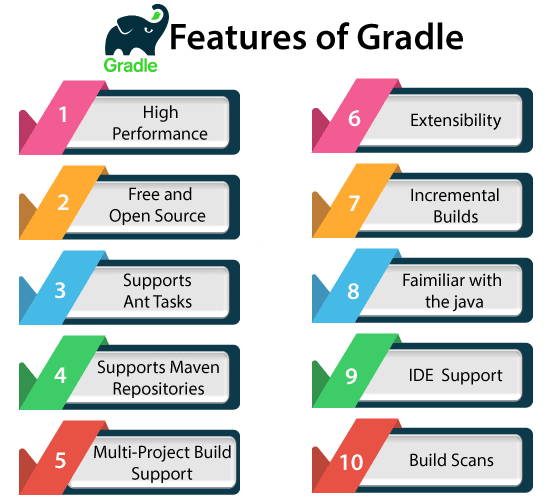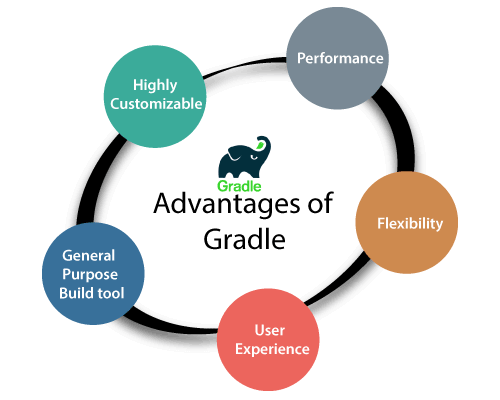Gradle Tutorial

Gradle tutorial provides basic and advanced concepts of the Gradle tool. Our Gradle tutorial is developed for beginners and professionals.
Our Gradle tutorial includes project task, installation and configuration, Gradle build, Gradle Build Scans, Gradle dependencies, Gradle Projects, Gradle eclipse plug-in, Gradle with Java, Gradle with spring, Gradle with Android and more concepts related to Gradle.
Gradle is an advanced general-purpose build management tool that is based on Groovy and Kotlin. It is a build automation tool that is an open-source and based on the concepts of Apache Maven and Apache Ant. It is developed for the multi-projects, which can be quite large. It has been developed for building automation on many languages and platforms, including Java, Scala, Android, C / C ++, and Groovy.
What is Gradle?
Gradle is an open source build automation tool that is based on the concept of Apache Maven and Apache Ant. It is capable of building almost any type of software. It is designed for the multi-project build, which can be quite large. It introduces a Java and Groovy-based DSL(Domain Specific Language) instead of XML (Extensible Markup Language) for declaring the project configuration. It uses a DAG (Directed Acyclic Graph) to define the order of executing the task.
Gradle offers an elastic model that can help the development lifecycle from compiling and packaging code for web and mobile applications. It provides support for the building, testing, and deploying software on different platforms. It has been developed for building automation on many languages and platforms, including Java, Scala, Android, C / C ++, and Groovy. Gradle provides integration with several development tools and servers, including Eclipse, IntelliJ, Jenkins, and Android Studio.
Gradle is used by large projects such as Spring Projects, Hibernate Projects, and Grails Projects. Some Leading Enterprise companies like LinkedIn and Netflix use Gradle.
Gradle was initially released in 2007, and it is stably released on November 18, 2019 (latest version 6.0.1). Gradle has taken the advantages of both Ant and Maven and remove the drawbacks of both.
What is a Build Tool?
Build tools are programs that are used to automate the creation of executable applications from source code. The building process involves compiling, linking, and packaging the code into a useful or executable form. Developers often implement the build process manually for small projects. But this cannot be done for large projects where it is complicated to keep track of what is needed for construction, in what order, and what dependencies are in the building process. Using the automation tools makes the build process more consistent.
Projects and Tasks in Gradle
Gradle describes everything on the basis of projects and tasks. Every Gradle build contains one or more projects, and these projects contain some tasks.
Gradle Projects
In Gradle, A project represents a library JAR or a web application. It may also represent a distribution ZIP, which is assembled from the JARs produced by other projects. A project could be deploying your application to staging or production environments. Each project in Gradle is made up of one or more tasks.
Gradle Tasks
In Gradle, Task is a single piece of work that a build performs. For example, it could compile classes, create a JAR, Generate Javadoc, and publish some archives to a repository and more.
Features of Gradle
Some remarkable features of Gradle are as follows:

High Performance
Gradle quickly completes the task by reusing the output from the previous execution. It processes tasks whose only input is changed and executes the task in parallel. Thus it avoids unnecessary tasks and provides faster performance.
Free and open-source
Gradle is an open-source tool and is licensed under the Apache License (ASL).
Provide support for Ant Tasks and Maven repositories
Gradle provides support for the Ant build projects; we can import an Ant build project and reuse all of its tasks. However, we can also make Ant-based Gradle tasks. The integration includes the properties, paths, and more.
Gradle supports the Maven repository. Maven Repositories are designed to publish and fetch dependencies of the project. Therefore we can continue to use any available repository infrastructure.
Multi-project build support
Gradle provides powerful support for the multi-project builds. A multi-project build may contain a root project and one or more subprojects that may also have subprojects. We can flexibly define our layout with the Gradle.
A project can simply be dependent on other projects or dependencies. We can describe a graph of dependencies among projects. Gradle also supports partial builds. It means that Gradle will find out whether a project, upon which our project depends, needs to be rebuilt. If the project needs to be rebuilt, Gradle will do so before building our own project.
Extensibility
Extensibility is one of the decent features of Gradle. We can easily extend the Gradle to provide our task types or build models. For an example of this, see Android Build Support: It adds several new build concepts such as flavor and builds types.
Incremental Builds
Gradle facilitates us with an incremental build, which means it executes only the necessary tasks. If we compile source code, it will check if the sources have changed since the previous execution. If the code is changed, then it will be executed; but, if the code is not changed, then it will skip the execution, and the task is marked as updated. There are many algorithms in Gradle to do so.
Familiar with the Java
We need a JVM to run the Gradle, so our machine should have a Java Development Kit (JDK). Gradle is familiar with most of the Java features. It is a bonus for the java users as we can use the standard Java APIs in our build logic, such as plug-ins and custom tasks. Therefore it makes it easy to run Gradle on different platforms.
Gradle isn’t limited to building just JVM projects; it also provides support for building native projects.
IDE Support
Gradle has support for several IDE’s. They are allowed to import the Gradle builds and interact with them. Gradle also generates the required solution files to load a project into Visual Studio.
Build Scans
The Build Scans provides comprehensive information about build run that can be used to identify build issues. They also help us to diagnose the problems with a build’s performance. The build scans can be shared with others; this can be useful if we need the advice to fix an issue with the build.
Advantages of Gradle
Some significant benefits of Gradle are as following:

Highly Customizable
Gradle is highly customizable and extensible. It can be customized to different projects under different technologies. It can be customized in many ways like it can be used in Java projects, Android projects, Groovy projects, and more.
Performance
Gradle is very fast in performance. It is about two times faster than Maven in all scenarios and a hundred times faster in large builds using build-cache.
Flexibility
Gradle is a flexible tool. Gradle is a plug-in based build tool. We can create our plug-in in different programming language like Java, Groovy, Kotlin, Scala, and more. If we want to add any functionality after deployment to the project, to do this, we can create a plug-in and give control to the codebase.
User Experience
Gradle supports a wide range of IDE’s to provide an improved user experience. Most people prefer to work on the IDE, but many users prefer to work on the terminal, Gradle provides a command-line interface for them. Gradle command-line interface offers many powerful features like Gradle Tasks, Command line completion, and more.
It also provides interactive web-based UI for debugging and optimizing builds.
Gradle is a general-purpose build tool
Gradle is a general-purpose build tool; it allows us to build any type of software.
Why Gradle?
Gradle is a modern build tool that comes up thinking about the challenges we have faced on other tools like ANT and Maven. The build tool should help us accomplish the goal of automating the project. Therefore we should not compromise on maintainability, usability, flexibility, extendibility, or performance.
It is developed to overcome the drawbacks of Maven and Ant and supports a wide range of IDEs. It features lots of plug-ins that can be written on our prediction. Also, it can be used for large projects such as Spring projects, Hibernate projects, and Grails projects. So it may be the right choice for us to choose Gradle as our build tool.
Prerequisite
Before learning Gradle, you must have a basic knowledge of Java programming and Groovy programming.
Audience
Our Gradle tutorial is designed to help beginners and professionals.
Problems
We assure you that you will not find any problem in this tutorial. But if you find any mistake, please post the problem in the contact form.
